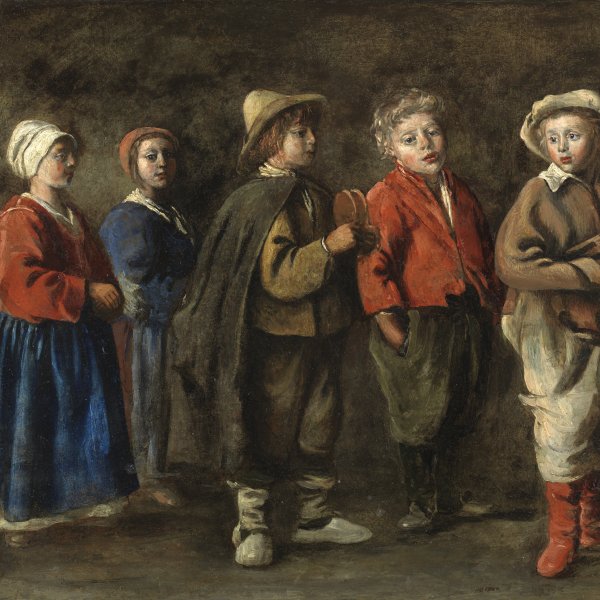The Rape of Europa
ca. 1640
Oil on canvas.
179 x 141.5 cm
Museo Nacional Thyssen-Bornemisza, Madrid
Inv. no.
428
(1966.4
)
Room 13
Level 2
Permanent Collection
The Rape of Europa has been dated to the early 1640s during the years that Vouet was in Paris between 1627 and 1649, the date of his death. In addition to its style, which conforms to the artist’s work at this period, its date was established on the basis of an engraving by Michel Dorigny of 1642 in which the composition is reproduced. The subject and format of the work has led to it being associated with the decorative cycles that Vouet painted for royal, aristocratic and wealthy bourgeois residences. These have not survived but are known through prints. The artist’s arrival in Paris in 1627 brought about a revival in French painting as he introduced Italian innovations using a classical style that offered a more restrained manner in comparison to the exuberance of the Baroque. Vouet achieved fame in Rome, where he settled in 1614, while his subsequent Paris period was also notably successful.
The present Rape of Europa faithfully follows Ovid’s text in The Metamorphoses. Jupiter, who has fallen in love with Europa, daughter of the King of Tyre, has transformed himself into a bull and mingles with the cattle on the seashore where she is playing with her companions. According to Ovid, Jupiter differed from the other bulls due to “the extreme whiteness of his coat, the very colour of snow, and his shorter, smoother horns, the colour of a pearl”. Appreciating the animal’s beauty, Europa approached him and covered his horns with flowers. The animal’s docility encouraged her to sit on its back, at which moment Jupiter made his escape with her, plunging into the water. Vouet has chosen the moment just prior to the flight, when Europa has placed the flowers on the beast’s head and is sitting on its back, while one of her companions ties a garland of flowers around her upper arm. The scene takes place in the foreground, while the very centre of the composition is occupied by one of Europa’s bare breasts. Vouet organises the colour in a masterful manner, applying large areas of single colours in the tunics and cloaks of the figures in primary hues such as blue, yellow and red of varying shades. He also places emphasis on the white of the bull and the pale flesh tones of the two women in the foreground. This pale, glowing colour range contrasts with the background of a dense mass of trees whose leaves are outlined against the sky and which has darkened in tone over the years. The note of sexual desire in the painting is provided by the bull, which Vouet has depicted with spittle dripping from its muzzle and a somewhat licentious expression.
This composition became widely known through the engraving by Dorigny. Two old copies are known of the painting as well as versions of the principal group in painted enamel, for example, on the back of a watch in the Metropolitan Museum, New York, in which the central group appears. It has been suggested that Vouet was inspired by the painting by Veronese in the Palazzo Ducale in Venice.
Mar Borobia
The present Rape of Europa faithfully follows Ovid’s text in The Metamorphoses. Jupiter, who has fallen in love with Europa, daughter of the King of Tyre, has transformed himself into a bull and mingles with the cattle on the seashore where she is playing with her companions. According to Ovid, Jupiter differed from the other bulls due to “the extreme whiteness of his coat, the very colour of snow, and his shorter, smoother horns, the colour of a pearl”. Appreciating the animal’s beauty, Europa approached him and covered his horns with flowers. The animal’s docility encouraged her to sit on its back, at which moment Jupiter made his escape with her, plunging into the water. Vouet has chosen the moment just prior to the flight, when Europa has placed the flowers on the beast’s head and is sitting on its back, while one of her companions ties a garland of flowers around her upper arm. The scene takes place in the foreground, while the very centre of the composition is occupied by one of Europa’s bare breasts. Vouet organises the colour in a masterful manner, applying large areas of single colours in the tunics and cloaks of the figures in primary hues such as blue, yellow and red of varying shades. He also places emphasis on the white of the bull and the pale flesh tones of the two women in the foreground. This pale, glowing colour range contrasts with the background of a dense mass of trees whose leaves are outlined against the sky and which has darkened in tone over the years. The note of sexual desire in the painting is provided by the bull, which Vouet has depicted with spittle dripping from its muzzle and a somewhat licentious expression.
This composition became widely known through the engraving by Dorigny. Two old copies are known of the painting as well as versions of the principal group in painted enamel, for example, on the back of a watch in the Metropolitan Museum, New York, in which the central group appears. It has been suggested that Vouet was inspired by the painting by Veronese in the Palazzo Ducale in Venice.
Mar Borobia
Emotions through art
This artwork is part of a study we conducted to analyze people's emotional responses when observing 125 pieces from the museum.
Joy: 66.9%
Disgust: 1.56%
Contempt: 0.27%
Anger: 2.05%
Fear: 5.28%
Surprise: 12.38%
Sadness: 11.56%










